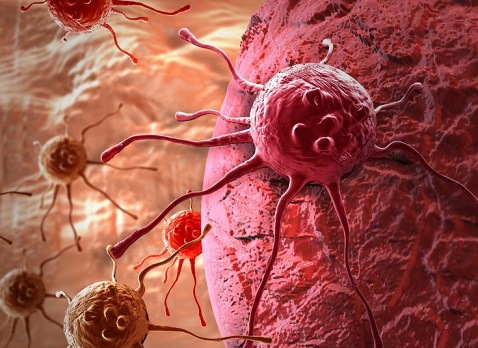Nikhil Prasad Fact checked by:Thailand Medical News Team Jun 25, 2024 10 months, 19 hours, 41 minutes ago
Cancer News: Tumor dormancy is a complex phenomenon where cancer cells can halt their growth for an extended period before suddenly becoming active again. This dormant state can make tumors challenging to detect and treat, leading to unexpected relapses even after successful therapy. Understanding the mechanisms behind tumor dormancy and reactivation is crucial for developing better cancer treatments. This
Cancer News report is based on a study review conducted by researchers from Far Eastern Federal University-Russia, Trauma and Specialist Hospital, Winneba-Ghana, Technische Universität München (TUM), Munich-Germany, the Institute of Cytology of the Russian Academy of Sciences (RAS)-Russia and Almazov National Medical Research Centre-Russia.
 Unlocking the Secrets of Tumor Dormancy and Reactivation
What is Tumor Dormancy?
Unlocking the Secrets of Tumor Dormancy and Reactivation
What is Tumor Dormancy?
Tumor dormancy occurs when cancer cells enter a state of inactivity. There are two types: tumor mass dormancy and cellular dormancy. Tumor mass dormancy happens when the tumor's growth and death rates are balanced, making the tumor clinically undetectable. Cellular dormancy involves solitary cancer cells that stop dividing but remain alive, capable of reactivating later.
Dormant cells have unique characteristics, such as a lower metabolic rate and changes in their genetic and epigenetic structures. These cells can survive in a dormant state for years, often evading traditional treatments.
The Role of the Microenvironment
The microenvironment where dormant cells reside plays a significant role in maintaining dormancy. Factors like hypoxia (low oxygen levels), autophagy (cellular self-digestion), and specific signaling pathways help sustain the dormant state. Proteins such as Wnt, Notch, TGFβ, and Hedgehog are involved in these processes.
Additionally, small GTPase Cdc42 has been linked to maintaining dormancy by promoting growth arrest through p38 signaling. However, the ability of senescent cells (cells that have stopped dividing permanently) to revert to an active state remains a topic of debate.
Intro To Heat Shock Proteins
Heat shock proteins (HSPs) are a group of proteins that cells produce when exposed to various stressful conditions. Initially identified in relation to heat shock, they are also expressed during other forms of stress such as cold exposure, UV light, and during processes like wound healing and tissue remodeling. These proteins often act as chaperones, stabilizing new proteins to ensure they fold correctly or assisting in refolding proteins that have been damaged due to stress. This increased expression of HSPs is regulated at the transcriptional level and is a crucial part of the heat shock response, primarily triggered by heat shock factor (HSF). HSPs are present in nearly all living organisms, ranging from bacteria to humans
The naming of heat shock proteins is based on their molecular weight. For example, Hsp60, Hsp70, and Hsp90 are among the most studied HSPs and refer to protein families with molec
ular weights of approximately 60, 70, and 90 kilodaltons, respectively. Additionally, the small 8-kilodalton protein ubiquitin, which tags proteins for degradation, shares characteristics with heat shock proteins. Small heat shock proteins (sHSPs) contain a conserved protein binding domain of around 80 amino acids known as alpha crystallins.
Heat Shock Proteins: Guardians of Tumor Dormancy
Heat shock proteins (HSPs) are crucial in protecting cells from stress and play a significant role in maintaining tumor dormancy. These proteins help fold and unfold other proteins, ensuring cell survival under stressful conditions like hypoxia, low pH, and oxidative stress. HSPs are often found in higher levels in tumors and are associated with treatment resistance.
HSPs also contribute to various tumorigenesis processes, including invasion, metastasis, angiogenesis (formation of new blood vessels), and the maintenance of signaling pathways. Recent research highlights their potential role in keeping cancer cells dormant and reactivating them under certain conditions.
Why Dormant Tumors Reactivate
Several factors can trigger the reactivation of dormant tumors, leading to cancer relapse. Changes in the tumor microenvironment, such as inflammation or alterations in blood supply, can wake up dormant cells. Proteins and signaling molecules involved in these processes include neutrophil elastase, MMP-9, and integrin signaling pathways.
Another critical factor is immune editing, where the immune system interacts with tumors, sometimes leading to dormancy and other times to aggressive tumor growth. Tumor cells can adapt to evade immune surveillance, leading to their reactivation.
Challenges and Clinical Implications
Tumor dormancy presents significant challenges in cancer treatment. Dormant cells can evade detection and resist conventional therapies, making it difficult to achieve a complete cure. Even when tumors appear to be in remission, dormant cells can reactivate, causing relapse.
This unpredictability makes it challenging for doctors to decide whether to treat dormant tumors and when to do so. The resistance of reactivated tumors to chemotherapy and radiation further complicates treatment strategies.
Future Directions: Research and Therapy
Understanding the mechanisms of tumor dormancy and reactivation is crucial for developing new therapeutic approaches. Researchers are exploring predictive markers and risk stratification tools to better manage dormant tumors. Immunotherapy and other alternative treatments show promise, but more research is needed.
By targeting the pathways and proteins involved in maintaining dormancy, scientists hope to either eradicate dormant cells or keep them in a dormant state indefinitely. Heat shock proteins and other molecular targets are under investigation for their potential to improve treatment outcomes.
Conclusion
Tumor dormancy and reactivation are critical areas of cancer research with significant clinical implications. By unraveling the complex biological processes that keep cancer cells dormant and the triggers that reactivate them, scientists can develop more effective treatments and improve the prognosis for cancer patients.
Continued research into the role of heat shock proteins, the tumor microenvironment, and immune interactions will pave the way for innovative therapies that can manage or eliminate dormant cancer cells, ultimately leading to better patient outcomes
The study review was published in the peer reviewed journal: Cells.
https://www.mdpi.com/2073-4409/13/13/1087
For the latest
Cancer News, keep on logging to Thailand Medical News.
Read Also:
https://www.thailandmedical.news/news/sars-cov-2-spike-suppresses-p53-dependent-gene-activation-impacting-tumorigenesis-tumor-progression-and-chemotherapy-sensitivity
https://www.thailandmedical.news/news/breaking-sars-cov-2-causes-aggressive-breast-cancer-progression-and-manipulates-tissue-stem-cells-in-the-tumor-microenvironment
